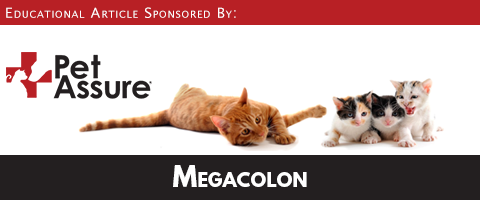The gastrointestinal tract ends with the colon, which stores the feces and then contracts to push the feces out of the body. If the nerves stimulating the colon are not working, the muscles stretch and the colon enlarges. It fills up with hard fecal material, and results in extreme constipation.
CAUSES:
More than half of cases are idiopathic (the cause cannot be found).
Some possible causes include:
- Narrowing of the pelvic area
- Nerve or spinal cord injury
- Spinal cord deformities
- Blockages (tumors, hairballs etc.)
- Recurrent constipation
- Colon cancer
SIGNS:
Common signs that may show megacolon in cats are:
- Hard, dry, bloody feces
- Severe constipation
- Involuntary urination
- Loss of appetite and weight loss
- Vomiting and dehydration
- Lethargy
DIAGNOSIS:
To properly diagnose your cat with megacolon, your veterinarian may perform the following:
- Abdominal examination
- X-rays
- Digital rectal exam
- Neurological exam
- Blood and urine tests
- Colonoscopy
- Biopsies
TREATMENT:
Most veterinarians will recommend the following treatments for cats with megacolon:
- Enemas: to flush out the hardened fecal material
- IV Fluid therapy: for dehydration
- Oral medication: to stimulate the colon to contract and to soften the stool
- Diet change: more fiber and water
For cats that do not respond to treatment, your veterinarian may recommend surgery to remove the colon or widen the pelvic area.
PREVENTION:
Megacolon is difficult to prevent. Cats prone to constipation may benefit from a fiber-supplemented diet, laxatives and/or enemas. You should make sure there is freshdrinking water available at all times.
PROGNOSIS:
Surgery is generally successful, and most cats will recover with treatment.
Recurrences may occur, and some cats will have diarrhea for a few months after recovering.



